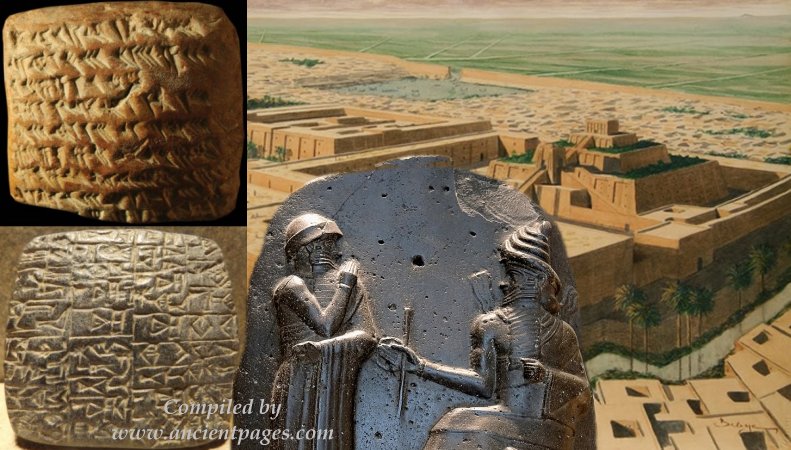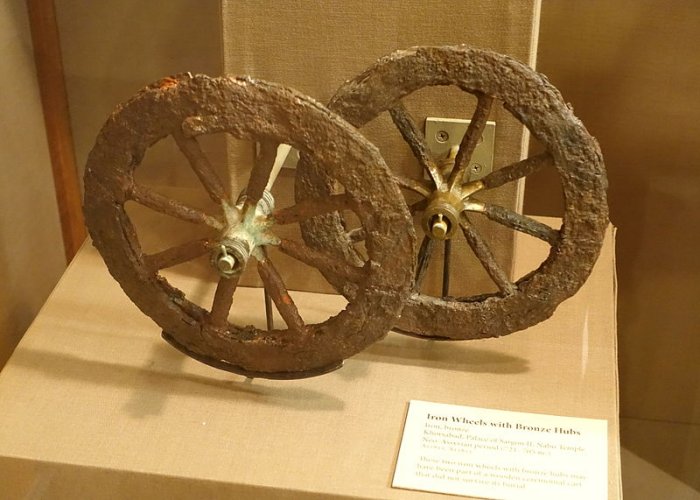How Did Mesopotamia Change The World?
Ellen Lloyd – AncientPages.com - Most scholars agree the ancient Sumerians were the earliest developed civilization in our recorded history. Mesopotamia is, therefore, often characterized as the cradle of civilization, but how exactly did Sumerians change the world?
Ancient people were familiar with art long before the birth of the Sumerian civilization and practiced agriculture around 8,000 B.C. Still, the power of Mesopotamia was that Sumerians took many aspects of human culture and transformed them into what we today call civilization.
The ancient Sumerians, the "black-headed ones," emerged upon the flood plain of the lower reaches of the Tigris and Euphrates Rivers about 4000 B.C., what today is modern Iraq. The Sumerians were by no means the first people on our planet, but they were the first in many areas of expertise. To understand how much we owe the ancient Sumerians, one has to take a quick look at some objects and technology we take for granted today.
Clay Tablets Shed Light On Ancient Sumerians' History
"They are the culture that gave us a lot of firsts: the first kingdom, and then empire, the first city-states, the first democracy, the first autocracy; they pioneered writing, schooling, organized religion, lawmaking, art, and literature." 1
Piecing together the ancient history of this long-gone civilization has been possible because scientists discovered valuable information that sheds light on Sumerians' daily life.
"Historians, archeologists, cultural anthropologists, and geologists have done most of the literal dirty work by unearthing an increasingly higher number of clues about the fascinating lives of the Sumerians.
Among these source materials are thousands of clay tablets, inscriptions, architectural ruins, brick molds, tools, columns, sculptures, art, metals, steles and cylinders." 2
Writing Was Invented In Mesopotamia
From a Sumerian epic poem entitled "Inanna and Enki," we learn that the art of writing was among many essential elements of civilization, transferred from Eridu, the City of the Kings, to Uruk. The writing was dedicated to the people of earth by Enki, God of Wisdom.
"More than 5000 years ago, people living in Mesopotamia developed a form of writing to record and communicate different types of information. The early form of writing was based on pictograms, which helped to communicate basic information about crops and taxes." 3
The word cuneiform means "wedge-shaped," and using these cuneiform tablets, Sumerians developed a script that bears a close resemblance to writing today. In the beginning, they used 1,000 characters, but later, they successfully ensured more clarity in the script with about 400 characters. Around the year 2,500 B.C., the Sumerian script became much more advanced. It was no longer limited to information about crops and taxes, but also portray emotions such as fear, anger, or hope.
Moral Codes And Laws Developed In Mesopotamia
Like in most ancient societies, priests were held in high regard. Claiming they could communicate with the gods, priests took their place at the top of the social hierarchy, and eventually, a class system was developed.
The importance of religion "inspired of moral codes, which led to formal rules and in turn, punishment for those who disobeyed." 4
Today the most famous ancient law code is the Code of Hammurabi, the sixth king in the Babylonian dynasty, who ruled in central Mesopotamia (modern Iraq) from 1792 to 1750 B.C. What is sometimes forgotten is that before the Babylonian king proclaimed one of the earliest and most complete ancient legal codes, there was another old law code.
The Code of Hammurabi was predated by the code of Lipit-Ishtar, the ruler of Isin around 1900 B.C., who was powerful enough to proclaim himself king of Sumer and Akkad. The Sumerian king Ur-Nammu also wrote a law code that was intended to protect the weak from the mighty.
Money Did Exist In Mesopotamia
Some doubt the existence of money in Mesopotamia, but it did exist. "For 4,500 years, human life was controlled and even manipulated by money. Ever since ancient times, money has played a central role in people's lives, regardless of whether payment has been rare shells, worthless iron coins, small springs or stamped precious metal pieces." 5
According to experts, "Mesopotamian monies are distinguished from ordinary commodities by being exchanged, sometimes for one another, more often as payments for other tangible commodities or for other less tangible goods, such as freedom from obligations of various sorts (taxes, loans with interest, fines and so on), and at more or less stable rates. They were used as indices or standards of value and were stockpiled as storable wealth." 6
Ancient Sumerians Were The First To Use A base 60 Numerical System
Many ancient civilizations kept track of time in various ways, but ancient Sumerians were the "first in recorded history to use a base 60 numerical system that led to our 60-second minutes and 60-minute hours. Many believe that that this helped the Babylonians to make such impressive advances in mathematics, as 60 has many divisors. They also used a lunar calendar, which comprised 12 lunar months, at an average of 29.5 days each. This left the Mesopotamians short by around 11 days a year, so they added seven months in each 19-year period to keep the seasons aligned. "4
Oldest Evidence Of The Invention Of The Wheel Comes From Mesopotamia
It isn't easy to imagine what our modern society would be like without proper transport. The invention of the wheel has been traced to Mesopotamia, where people came up with the idea around 3,500 B.C, in the late Bronze Age. Historians think different civilizations started to use the wheel independently around the same time. We cannot say with certainty that the ancient Sumerians were the first to use the wheel, but based on archaeological evidence, it seems the oldest example comes from Mesopotamia.
The wheel was invented in Mesopotamia. Credit: Public Domain
Ancient Sumerians led the foundation of what is today defined as a civilization. Their inventions inspired and influenced "the entirety of the Ancient Middle East, and their accomplishments and innovations echo in diverse ancient cultures such as Egypt, Greece, Rome, Ethiopia, and more.
From a practical, mundane standpoint, they were a highly religious, agricultural society that put great emphasis on art, culture, and the written word.
As is the case with all cultures, they developed from simpler hunter-gatherer societies, based on the Bronze age sites scattered about the area that comprised Ancient Sumer. They were an innovative, inventive, imaginative people and, interestingly enough, had parallels with even modern-day societies in both positive and negative aspects of their daily lives." 1
So, it's certainly not without a reason historians and archaeologists refer to Mesopotamia as the cradle of civilization.
Updated on September 30, 2023
Written by Ellen Lloyd – AncientPages.com
Copyright © AncientPages.com All rights reserved. This material may not be published, broadcast, rewritten or redistributed in whole or part without the express written permission of AncientPages.com
Expand for references- History, Captivating. Sumerians: A Captivating Guide to Ancient Sumerian History, Sumerian Mythology and the Mesopotamian Empire of the Sumer Civilization
- Henry Freeman - Sumerians: A History From Beginning to End
- A. Sutherland - Cuneiform Tablets: One Of The Earliest Systems Of Writing Invented By The Sumerians, AncientPages.com
- How it Works Book Of Incredible History Twelfth Edition, Future Publishing Limited
- A. Sutherland - Our Lives Have Always Been Manipulated By Money – Part 1 - 3, AncientPages.com
- Powell, Marvin A. "Money in Mesopotamia." Journal of the Economic and Social History of the Orient39, no. 3 (1996): 224-42. Accessed January 17, 2020.
More From Ancient Pages
-
 Unique Sword Casts New Light On Viking Voyages Across The North Sea
Archaeology | Jul 18, 2022
Unique Sword Casts New Light On Viking Voyages Across The North Sea
Archaeology | Jul 18, 2022 -
 Ancient DNA Reveals How Yamnaya People Re-Wrote Northern Europeans’ Genetic Story 5,000 Years Ago
DNA | Jan 12, 2024
Ancient DNA Reveals How Yamnaya People Re-Wrote Northern Europeans’ Genetic Story 5,000 Years Ago
DNA | Jan 12, 2024 -
 Qumran: The Dead Sea Scrolls And Their Connection To Enigmatic Essenes
Civilizations | Feb 20, 2016
Qumran: The Dead Sea Scrolls And Their Connection To Enigmatic Essenes
Civilizations | Feb 20, 2016 -
 Modern Humans Traveled Across The Eurasian Steppe 45,000 Years Ago
Archaeology | Aug 20, 2019
Modern Humans Traveled Across The Eurasian Steppe 45,000 Years Ago
Archaeology | Aug 20, 2019 -
 Sigurd Fafnirsbane – Legendary Dragon Slaying Warrior And His Magical Sword
Featured Stories | Oct 30, 2017
Sigurd Fafnirsbane – Legendary Dragon Slaying Warrior And His Magical Sword
Featured Stories | Oct 30, 2017 -
 Seven Bronze Age Swords And Large Hoard Of Slavic Coins Found In Germany
Archaeology | Dec 4, 2023
Seven Bronze Age Swords And Large Hoard Of Slavic Coins Found In Germany
Archaeology | Dec 4, 2023 -
 2,000-Year-Old Huge Terracotta Jar Discovered In Turkey
Archaeology | Jan 2, 2018
2,000-Year-Old Huge Terracotta Jar Discovered In Turkey
Archaeology | Jan 2, 2018 -
 Vijayanagara – ‘City Of Devas – Shining Ones’ – Place Where Mythology And History Coexist
Civilizations | Jun 21, 2015
Vijayanagara – ‘City Of Devas – Shining Ones’ – Place Where Mythology And History Coexist
Civilizations | Jun 21, 2015 -
 King Henry VIII’s Walking Staff And Other Unusual Weapons
Artifacts | Nov 1, 2017
King Henry VIII’s Walking Staff And Other Unusual Weapons
Artifacts | Nov 1, 2017 -
 Norse Legend Of Hero Sigmund And The Magical Sword In The Branstock Tree
Featured Stories | Jun 25, 2016
Norse Legend Of Hero Sigmund And The Magical Sword In The Branstock Tree
Featured Stories | Jun 25, 2016 -
 On This Day In History: Galilei Galileo Demonstrates His First Telescope – August 25, 1609
News | Aug 25, 2016
On This Day In History: Galilei Galileo Demonstrates His First Telescope – August 25, 1609
News | Aug 25, 2016 -
 Illapa: Powerful Master Of Clouds, Rain And Hail – Worshipped By Inca People
Featured Stories | Jul 7, 2016
Illapa: Powerful Master Of Clouds, Rain And Hail – Worshipped By Inca People
Featured Stories | Jul 7, 2016 -
 Mjölnir: Thor’s Terrible Axe-Hammer And Its Magical Powers In Norse Mythology
Featured Stories | Apr 20, 2017
Mjölnir: Thor’s Terrible Axe-Hammer And Its Magical Powers In Norse Mythology
Featured Stories | Apr 20, 2017 -
 On This Day In History: Henry VIII Ascended The Throne Of England – On Apr 22, 1509
News | Apr 22, 2016
On This Day In History: Henry VIII Ascended The Throne Of England – On Apr 22, 1509
News | Apr 22, 2016 -
 On This Day In History: Battle Of Rudau Was Fought – On Feb 17, 1370
News | Feb 17, 2017
On This Day In History: Battle Of Rudau Was Fought – On Feb 17, 1370
News | Feb 17, 2017 -
 When And What Was The Golden Age Of Piracy?
Ancient History Facts | Jul 25, 2016
When And What Was The Golden Age Of Piracy?
Ancient History Facts | Jul 25, 2016 -
 Dracula: Cruel, Ruthless And Bloodthirsty Ruler But Not A Vampire
Featured Stories | Sep 12, 2023
Dracula: Cruel, Ruthless And Bloodthirsty Ruler But Not A Vampire
Featured Stories | Sep 12, 2023 -
 Search For A Viking Cemetery Near Truso Settlement In Janow, Poland – Continues
Archaeology | Jul 23, 2020
Search For A Viking Cemetery Near Truso Settlement In Janow, Poland – Continues
Archaeology | Jul 23, 2020 -
 Bristol Academic Cracks Voynich Code – Century-Old Mystery Solved
Archaeology | May 15, 2019
Bristol Academic Cracks Voynich Code – Century-Old Mystery Solved
Archaeology | May 15, 2019 -
 DNA Study Reveals 250 Siberians Became The First Native American Population
Archaeology | May 12, 2018
DNA Study Reveals 250 Siberians Became The First Native American Population
Archaeology | May 12, 2018



